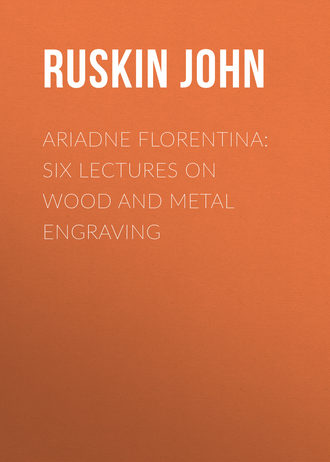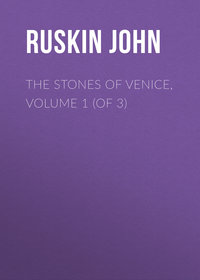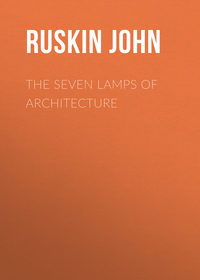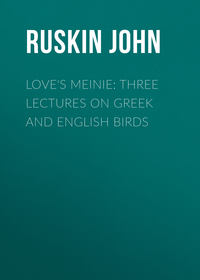 полная версия
полная версияAriadne Florentina: Six Lectures on Wood and Metal Engraving

John Ruskin
Ariadne Florentina: Six Lectures on Wood and Metal Engraving
LECTURE I
DEFINITION OF THE ART OF ENGRAVING1. The entrance on my duty for to-day begins the fourth year of my official work in Oxford; and I doubt not that some of my audience are asking themselves, very doubtfully—at all events, I ask myself, very anxiously—what has been done.
For practical result, I have not much to show. I announced, a fortnight since, that I would meet, the day before yesterday, any gentleman who wished to attend this course for purposes of study. My class, so minded, numbers four, of whom three wish to be artists, and ought not therefore, by rights, to be at Oxford at all; and the fourth is the last remaining unit of the class I had last year.
2. Yet I neither in this reproach myself, nor, if I could, would I reproach the students who are not here. I do not reproach myself; for it was impossible for me to attend properly to the schools and to write the grammar for them at the same time; and I do not blame the absent students for not attending a school from which I have generally been absent myself. In all this, there is much to be mended, but, in true light, nothing to be regretted.
I say, I had to write my school grammar. These three volumes of lectures under my hand,1 contain, carefully set down, the things I want you first to know. None of my writings are done fluently; the second volume of "Modern Painters" was all of it written twice—most of it, four times,—over; and these lectures have been written, I don't know how many times. You may think that this was done merely in an author's vanity, not in a tutor's care. To the vanity I plead guilty,—no man is more intensely vain than I am; but my vanity is set on having it known of me that I am a good master, not in having it said of me that I am a smooth author. My vanity is never more wounded than in being called a fine writer, meaning—that nobody need mind what I say.
3. Well, then, besides this vanity, I have some solicitude for your progress. You may give me credit for it or not, as you choose, but it is sincere. And that your advance may be safe, I have taken the best pains I could in laying down laws for it. In these three years I have got my grammar written, and, with the help of many friends, all working instruments in good order; and now we will try what we can do. Not that, even now, you are to depend on my presence with you in personal teaching. I shall henceforward think of the lectures less, of the schools more; but my best work for the schools will often be by drawing in Florence or in Lancashire—not here.
4. I have already told you several times that the course through which I mean every student in these schools should pass, is one which shall enable them to understand the elementary principles of the finest art. It will necessarily be severe, and seem to lead to no immediate result. Some of you will, on the contrary, wish to be taught what is immediately easy, and gives prospect of a manifest success.
But suppose they should come to the Professor of Logic and Rhetoric, and tell him they want to be taught to preach like Mr. Spurgeon, or the Bishop of –.
He would say to them,—I cannot, and if I could I would not, tell you how to preach like Mr. Spurgeon, or the Bishop of –. Your own character will form your style; your own zeal will direct it; your own obstinacy or ignorance may limit or exaggerate it; but my business is to prevent, as far as I can, your having any particular style; and to teach you the laws of all language, and the essential power of your own.
In like manner, this course, which I propose to you in art, will be calculated only to give you judgment and method in future study, to establish to your conviction the laws of general art, and to enable you to draw, if not with genius, at least with sense and propriety.
The course, so far as it consists in practice, will be defined in my Instructions for the schools. And the theory connected with that practice is set down in the three lectures at the end of the first course I delivered—those on Line, Light, and Color.
You will have, therefore, to get this book,2 and it is the only one which you will need to have of your own,—the others are placed, for reference, where they will be accessible to you.
5. In the 139th paragraph it states the order of your practical study in these terms:—
"I wish you to begin by getting command of line;—that is to say, by learning to draw a steady line, limiting with absolute correctness the form or space you intend it to limit; to proceed by getting command over flat tints, so that you may be able to fill the spaces you have inclosed evenly, either with shade or color, according to the school you adopt; and, finally, to obtain the power of adding such fineness of drawing, within the masses, as shall express their undulation, and their characters of form and texture."
And now, since in your course of practice you are first required to attain the power of drawing lines accurately and delicately, so in the course of theory, or grammar, I wish you first to learn the principles of linear design, exemplified by the schools which (§ 137) you will find characterized as the Schools of Line.
6. If I had command of as much time as I should like to spend with you on this subject, I would begin with the early forms of art which used the simplest linear elements of design. But, for general service and interest, it will be better that I should sketch what has been accomplished by the greatest masters in that manner; the rather that their work is more or less accessible to all, and has developed into the vast industries of modern engraving, one of the most powerful existing influences of education and sources of pleasure among civilized people.
And this investigation, so far from interrupting, will facilitate our examination of the history of the nobler arts. You will see in the preface to my lectures on Greek sculpture that I intend them to be followed by a course on architecture, and that by one on Florentine sculpture. But the art of engraving is so manifestly, at Florence, though not less essentially elsewhere, a basis of style both in architecture and sculpture, that it is absolutely necessary I should explain to you in what the skill of the engraver consists, before I can define with accuracy that of more admired artists. For engraving, though not altogether in the method of which you see examples in the print-shops of the High Street, is, indeed, a prior art to that either of building or sculpture, and is an inseparable part of both, when they are rightly practiced.
7. And while we thus examine the scope of this first of the arts, it will be necessary that we learn also the scope of mind of the early practicers of it, and accordingly acquaint ourselves with the main events in the biography of the schools of Florence. To understand the temper and meaning of one great master is to lay the best, if not the only, foundation for the understanding of all; and I shall therefore make it the leading aim of this course of lectures to remind you of what is known, and direct you to what is knowable, of the life and character of the greatest Florentine master of engraving, Sandro Botticelli; and, incidentally, to give you some idea of the power of the greatest master of the German, or any northern, school, Hans Holbein.
8. You must feel, however, that I am using the word "engraving" in a somewhat different, and, you may imagine, a wider, sense, than that which you are accustomed to attach to it. So far from being a wider sense, it is in reality a more accurate and restricted one, while yet it embraces every conceivable right application of the art. And I wish, in this first lecture, to make entirely clear to you the proper meaning of the word, and proper range of the art of, engraving; in my next following lecture, to show you its place in Italian schools, and then, in due order, the place it ought to take in our own, and in all schools.
9. First then, to-day, of the Differentia, or essential quality of Engraving, as distinguished from other arts.
What answer would you make to me, if I asked casually what engraving was? Perhaps the readiest which would occur to you would be, "The translation of pictures into black and white by means admitting reduplication of impressions." But if that be done by lithography, we do not call it engraving,—whereas we speak contentedly and continually of seal engraving, in which there is no question of black and white. And, as scholars, you know that this customary mode of speaking is quite accurate; and that engraving means, primarily, making a permanent cut or furrow in something. The central syllable of the word has become a sorrowful one, meaning the most permanent of furrows.
10. But are you prepared absolutely to accept this limitation with respect to engraving as a pictorial art? Will you call nothing an engraving, except a group of furrows or cavities cut in a hard substance? What shall we say of mezzotint engraving, for instance, in which, though indeed furrows and cavities are produced mechanically as a ground, the artist's work is in effacing them? And when we consider the power of engraving in representing pictures and multiplying them, are we to recognize and admire no effects of light and shade except those which are visibly produced by dots or furrows? I mean, will the virtue of an engraving be in exhibiting these imperfect means of its effect, or in concealing them?
11. Here, for instance, is the head of a soldier by Dürer,—a mere gridiron of black lines. Would this be better or worse engraving if it were more like a photograph or lithograph, and no lines seen?—suppose, more like the head of Mr. Santley, now in all the music-shops, and really quite deceptive in light and shade, when seen from over the way? Do you think Dürer's work would be better if it were more like that? And would you have me, therefore, leaving the question of technical method of production altogether to the craftsman, consider pictorial engraving simply as the production of a light-and-shade drawing, by some method permitting its multiplication for the public?
12. This, you observe, is a very practical question indeed. For instance, the illustrations of my own lectures on sculpture are equivalent to permanent photographs. There can be little doubt that means will be discovered of thus producing perfect facsimiles of artists' drawings; so that, if no more than facsimile be required, the old art of cutting furrows in metal may be considered as, at this day, virtually ended. And, indeed, it is said that line engravers cannot any more get apprentices, and that a pure steel or copper plate is not likely to be again produced, when once the old living masters of the bright field shall have been all laid in their earth-furrows.
13. Suppose, then, that this come to pass; and more than this, suppose that wood engraving also be superseded, and that instead of imperfect transcripts of drawings, on wood-blocks or metal-plates, photography enabled us to give, quite cheaply, and without limit to number, facsimiles of the finished light-and-shade drawings of artists themselves. Another group of questions instantly offers itself, on these new conditions; namely, What are the best means for a light-and-shade drawing—the pen, or the pencil, the charcoal, or the flat wash? That is to say, the pen, producing shade by black lines, as old engraving did; the pencil, producing shade by gray lines, variable in force; the charcoal, producing a smoky shadow with no lines in it, or the washed tint, producing a transparent shadow with no lines in it. Which of these methods is the best?—or have they, each and all, virtues to be separately studied, and distinctively applied?
14. See how curiously the questions multiply on us. 1st, Is engraving to be only considered as cut work? 2d, For present designs multipliable without cutting, by the sunshine, what methods or instruments of drawing will be best? And now, 3dly, before we can discuss these questions at all, is there not another lying at the root of both,—namely, what a light-and-shade drawing itself properly is, and how it differs, or should differ, from a painting, whether by mere deficiency, or by some entirely distinct merit?
15. For instance, you know how confidently it is said, in common talk about Turner, that his works are intelligible and beautiful when engraved, though incomprehensible as paintings. Admitting this to be so, do you suppose it is because the translation into light and shade is deficient in some qualities which the painting had, or that it possesses some quality which the painting had not? Does it please more because it is deficient in the color which confused a feeble spectator, and offended a dogmatic one,—or because it possesses a decision in its steady linear labor which interprets, or corrects, the swift penciling of the artist?
16. Do you notice the two words I have just used, Decision, and Linear?—Decision, again introducing the idea of cuts or divisions, as opposed to gradations; Linear, as opposed to massive or broad?
Yet we use all these words at different times in praise, while they evidently mark inconsistent qualities. Softness and decision, breadth and delineation, cannot co-exist in equal degrees. There must surely therefore be a virtue in the engraving inconsistent with that of the painting, and vice versâ.
Now, be clear about these three questions which we have to-day to answer.
A. Is all engraving to be cut work?
B. If it need not be cut work, but only the reproduction of a drawing, what methods of executing a light-and-shade drawing will be best?
C. Is the shaded drawing itself to be considered only as a deficient or imperfect painting, or as a different thing from a painting, having a virtue of its own, belonging to black and white, as opposed to color?
17. I will give you the answers at once, briefly, and amplify them afterwards.
A. All engraving must be cut work;—that is its differentia. Unless your effect be produced by cutting into some solid substance, it is not engraving at all.
B. The proper methods for light-and-shade drawing vary according to subject, and the degree of completeness desired,—some of them having much in common with engraving, and others with painting.
C. The qualities of a light-and-shade drawing ought to be entirely different from those of a painting. It is not a deficient or partial representation of a colored scene or picture, but an entirely different reading of either. So that much of what is intelligible in a painting ought to be unintelligible in a light-and-shade study, and vice versâ.
You have thus three arts,—engraving, light-and-shade drawing, and painting.
Now I am not going to lecture, in this course, on painting, nor on light-and-shade drawing, but on engraving only. But I must tell you something about light-and-shade drawing first; or, at least, remind you of what I have before told.
18. You see that the three elementary lectures in my first volume are on Line, Light, and Color,—that is to say, on the modes of art which produce linear designs,—which produce effects of light,—and which produce effects of color.
I must, for the sake of new students, briefly repeat the explanation of these.
Here is an Arabian vase, in which the pleasure given to the eye is only by lines;—no effect of light, or of color, is attempted. Here is a moonlight by Turner, in which there are no lines at all, and no colors at all. The pleasure given to the eye is only by modes of light and shade, or effects of light. Finally, here is an early Florentine painting, in which there are no lines of importance, and no effect of light whatever; but all the pleasure given to the eye is in gayety and variety of color.
19. I say, the pleasure given to the eye. The lines on this vase write something; but the ornamentation produced by the beautiful writing is independent of its meaning. So the moonlight is pleasant, first, as light; and the figures, first, as color. It is not the shape of the waves, but the light on them; not the expression of the figures, but their color, by which the ocular pleasure is to be given.
These three examples are violently marked ones; but, in preparing to draw any object, you will find that, practically, you have to ask yourself, Shall I aim at the color of it, the light of it, or the lines of it? You can't have all three; you can't even have any two out of the three in equal strength. The best art, indeed, comes so near nature as in a measure to unite all. But the best is not, and cannot be, as good as nature; and the mode of its deficiency is that it must lose some of the color, some of the light, or some of the delineation. And in consequence, there is one great school which says, We will have the color, and as much light and delineation as are consistent with it. Another which says, We will have shade, and as much color and delineation as are consistent with it. The third, We will have delineation, and as much color and shade as are consistent with it.
20. And though much of the two subordinate qualities may in each school be consistent with the leading one, yet the schools are evermore separate: as, for instance, in other matters, one man says, I will have my fee, and as much honesty as is consistent with it; another, I will have my honesty, and as much fee as is consistent with it. Though the man who will have his fee be subordinately honest,—though the man who will have his honor, subordinately rich, are they not evermore of diverse schools?
So you have, in art, the utterly separate provinces, though in contact at their borders, of
The Delineators;
The Chiaroscurists; and
The Colorists.
21. The Delineators are the men on whom I am going to give you this course of lectures. They are essentially engravers, an engraved line being the best means of delineation. The Chiaroscurists are essentially draughtsmen with chalk, charcoal, or single tints. Many of them paint, but always with some effort and pain. Lionardo is the type of them; but the entire Dutch school consists of them, laboriously painting, without essential genius for color.
The Colorists are the true painters; and all the faultless (as far, that is to say, as men's work can be so,) and consummate masters of art belong to them.
22. The distinction between the colorist and chiaroscurist school is trenchant and absolute: and may soon be shown you so that you will never forget it. Here is a Florentine picture by one of the pupils of Giotto, of very good representative quality, and which the University galleries are rich in possessing. At the distance at which I hold it, you see nothing but a checker-work of brilliant, and, as it happens, even glaring colors. If you come near, you will find this patchwork resolve itself into a Visitation, and Birth of St. John; but that St. Elizabeth's red dress, and the Virgin's blue and white one, and the brown posts of the door, and the blue spaces of the sky, are painted in their own entirely pure colors, each shaded with more powerful tints of itself,—pale blue with deep blue, scarlet with crimson, yellow with orange, and green with richer green.
The whole is therefore as much a mosaic work of brilliant color as if it were made of bits of glass. There is no effect of light attempted, or so much as thought of: you don't know even where the sun is: nor have you the least notion what time of day it is. The painter thinks you cannot be so superfluous as to want to know what time of day it is.
23. Here, on the other hand, is a Dutch picture of good average quality, also out of the University galleries. It represents a group of cattle, and a herdsman watching them. And you see in an instant that the time is evening. The sun is setting, and there is warm light on the landscape, the cattle, and the standing figure.
Nor does the picture in any conspicuous way seem devoid of color. On the contrary, the herdsman has a scarlet jacket, which comes out rather brilliantly from the mass of shade round it; and a person devoid of color faculty, or ill taught, might imagine the picture to be really a fine work of color.
But if you will come up close to it, you will find that the herdsman has brown sleeves, though he has a scarlet jacket; and that the shadows of both are painted with precisely the same brown, and in several places with continuous touches of the pencil. It is only in the light that the scarlet is laid on.
This at once marks the picture as belonging to the lower or chiaroscurist school, even if you had not before recognized it as such by its pretty rendering of sunset effect.
24. You might at first think it a painting which showed greater skill than that of the school of Giotto. But the skill is not the primary question. The power of imagination is the first thing to be asked about. This Italian work imagines, and requires you to imagine also, a St. Elizabeth and St. Mary, to the best of your power. But this Dutch one only wishes you to imagine an effect of sunlight on cow-skin, which is a far lower strain of the imaginative faculty.
Also, as you may see the effect of sunlight on cow-skin, in reality, any summer afternoon, but cannot so frequently see a St. Elizabeth, it is a far less useful strain of the imaginative faculty.
And, generally speaking, the Dutch chiaroscurists are indeed persons without imagination at all,—who, not being able to get any pleasure out of their thoughts, try to get it out of their sensations; note, however, also their technical connection with the Greek school of shade, (see my sixth inaugural lecture, § 158,) in which color was refused, not for the sake of deception, but of solemnity.
25. With these final motives you are not now concerned; your present business is the quite easy one of knowing, and noticing, the universal distinction between the methods of treatment in which the aim is light, and in which it is color; and so to keep yourselves guarded from the danger of being misled by the, often very ingenious, talk of persons who have vivid color sensations without having learned to distinguish them from what else pleases them in pictures. There is an interesting volume by Professor Taine on the Dutch school, containing a valuable historical analysis of the influences which formed it; but full of the gravest errors, resulting from the confusion in his mind between color and tone, in consequence of which he imagines the Dutch painters to be colorists.
26. It is so important for you to be grounded securely in these first elements of pictorial treatment, that I will be so far tedious as to show you one more instance of the relative intellectual value of the pure color and pure chiaroscuro school, not in Dutch and Florentine, but in English art. Here is a copy of one of the lost frescoes of our Painted Chamber of Westminster;—fourteenth-century work, entirely conceived in color, and calculated for decorative effect. There is no more light and shade in it than in a Queen of Hearts in a pack of cards;—all that the painter at first wants you to see is that the young lady has a white forehead, and a golden crown, and a fair neck, and a violet robe, and a crimson shield with golden leopards on it; and that behind her is clear blue sky. Then, farther, he wants you to read her name, "Debonnairete," which, when you have read, he farther expects you to consider what it is to be debonnaire, and to remember your Chaucer's description of the virtue:—
She was not brown, nor dun of hue,But white as snowe, fallen new,With eyen glad, and browes bent,Her hair down to her heeles went,And she was simple, as dove on tree,Full debonnair of heart was she.27. You see Chaucer dwells on the color just as much as the painter does, but the painter has also given her the English shield to bear, meaning that good-humor, or debonnairete, cannot be maintained by self-indulgence;—only by fortitude. Farther note, with Chaucer, the "eyen glad," and brows "bent" (high-arched and calm), the strong life, (hair down to the heels,) and that her gladness is to be without subtlety,—that is to say, without the slightest pleasure in any form of advantage-taking, or any shrewd or mocking wit: "she was simple as dove on tree;" and you will find that the color-painting, both in the fresco and in the poem, is in the very highest degree didactic and intellectual; and distinguished, as being so, from all inferior forms of art. Farther, that it requires you yourself first to understand the nature of simplicity, and to like simplicity in young ladies better than subtlety; and to understand why the second of Love's five kind arrows (Beauté being the first)—











